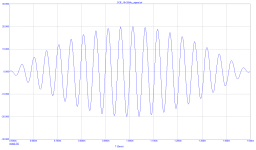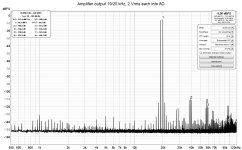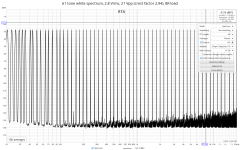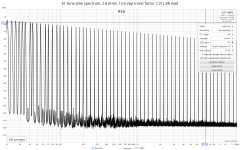That was not the intention. It happened to have two measurements of different class/power of amplifiers.Please do not bring ASR here. They believe THD is all there is. No need to listen.
Regds.
Its simple, hugh's 39watt se amp. I love it, i t makes beautifull sound.i dont have to reason why. I dont have analyse the sound.it simply bathes my soul in gd vibes.
Do you mean Hugh Dean's AN circuit, Michael?
If so, I agree - mine make a wonderful sound. 👍 But I wouldn't call it 'SE'??? (As it has both '+ve' and '-ve' DC rails.)
Maybe one thing to consider is that the usual tests will, at best, give the usual results, even if the presentation gives incremental improvements in filtering / discernment.It’s not about deciding if an amp is low distortion or not. If you look at what’s being proposed, an amp with 0.5 % distortion can still score quite highly, but an amp featuring 0.0001% (ie 1 ppm) that fails where it counts on other areas wing score as well. It’s about getting balance into amplifier ratings and making sure at the very least, they are well designed and engineered.
I don’t give anyone a hard time for building a 0.5% distortion amp. What I do object to is when either camp claims they have it right and the other is wrong.
🙂
Perhaps the tests themselves could do with a push for more development?
Take for instance, multi-tone tests. With half a century of single-tone THD testing, it's no wonder that the 'struggle' is on the side of test equipment to produce a pure enough sine wave, and on top of that a strong notch filter so as not to run out of dynamic range.
What happens if you double the number of sine waves? Does the noise only go up by 3dB? I doubt it! What if an array of 10 or 100 harmonically unrelated sines are used? And do we really need a huge array of analogue generators and notches? Perhaps a simple circuit could give a predictable output?
Ordinary dialogue and music can be split into thousands of sines and cosines, where each elemental wave has very low amplitude compared to the total. And if you look at a snapshot of such a wave, you're likely to see various unpredictable slopes, multiple reversals at various voltages, a lack of symmetry, and more. Occasional constructive interference as the waves sum to a high amplitude. Even a 'ringing' musical tone is unlikely to give exact repetitions.
In a similar vein, some people want an amplifier for a full-range speaker, while others want active filters. 19kHz + 20kHz IMD tests — while interesting — are kind-of nonsense.
1) The limit for most people, even in childhood is 15-16kHz. I was one of the few kids who could hear the squeal from TV sets and most people thought I was crazy. And don't get me started on cars with disc brakes. Life sucked.
2) Source material is likely to be filtered lower. Partly to limit the filter slope with 44k or 48k sampling rates, but also to reduce distortion in playback.
A more useful test might be 100Hz + 4kHz. Around 4kHz tends to be where the ear is extremely sensitive, and the opposite is true for 100Hz (or 50Hz, etc.) The 100Hz tone could be set to 100x higher amplitude than the 4kHz tone, and see what happens with sidebands.
Let’s get an opinion from the participants on which distortion test is best to assess amplifier linearity performance:-
THD single tone
IMD 19+20 kHz
Militi-tone
THD vs Freq
THD vs Power
Etc
THD single tone
IMD 19+20 kHz
Militi-tone
THD vs Freq
THD vs Power
Etc
We should keep in mind that a single type of distortion test does not fully characterise amplifier linearity. Some are done at full power, others (like multi-tone) can be at full power, but the output voltage swing in the amplifier is low because of the way power tones add. Anyway, food for thought.
I will try to do a first draft document sometime next week for review.
I’ve been thinking, maybe AFOM is not the right name since we already agreed the assessment must consist of a graph plus a top level score.
Any thoughts on what we should call this to better describe it?
I will try to do a first draft document sometime next week for review.
I’ve been thinking, maybe AFOM is not the right name since we already agreed the assessment must consist of a graph plus a top level score.
Any thoughts on what we should call this to better describe it?
Naming convention aside...
This might be called an evaluation protocol. Granted, the most accepted definition notes acceptance criteria, but ...
I'd steer away from acronyms / abbreviations and suggest something like:
Protocol For The Evaluation Of Consumer Audio Amplifiers
A distant second... since this really isn't a standard per se...
Standard Methodology For The Evaluation Of Consumer Audio Amplifiers
Long ... yes...
Within the protocol (depending on how deep this might go) ... you may consider citing specific test methods to be used. If specific documented methods are not available, then at a minimum, a synopsis re: how each test should be conducted along with sampling and reporting requirements should be included.
A set of tests with the same "name" doesn't have a lot of meaning if people are not conducting the tests in a controlled manner. I'm not suggesting that individuals cross-calibrate against known samples, but... if the goal is comparisons... anything within practical reason to minimize meaningful variability is a necessity.
Simply a suggestion... I am enjoying the fact that people skilled in the art are actually discussing this. It's exactly what I've been hoping for.
This might be called an evaluation protocol. Granted, the most accepted definition notes acceptance criteria, but ...
I'd steer away from acronyms / abbreviations and suggest something like:
Protocol For The Evaluation Of Consumer Audio Amplifiers
A distant second... since this really isn't a standard per se...
Standard Methodology For The Evaluation Of Consumer Audio Amplifiers
Long ... yes...
Within the protocol (depending on how deep this might go) ... you may consider citing specific test methods to be used. If specific documented methods are not available, then at a minimum, a synopsis re: how each test should be conducted along with sampling and reporting requirements should be included.
A set of tests with the same "name" doesn't have a lot of meaning if people are not conducting the tests in a controlled manner. I'm not suggesting that individuals cross-calibrate against known samples, but... if the goal is comparisons... anything within practical reason to minimize meaningful variability is a necessity.
Simply a suggestion... I am enjoying the fact that people skilled in the art are actually discussing this. It's exactly what I've been hoping for.
I wonder myself isn’t a two tone IMD measurement as inadequate as is 1 kHz THD?Let’s get an opinion from the participants on which distortion test is best to assess amplifier linearity performance:-
THD single tone
IMD 19+20 kHz
Militi-tone
THD vs Freq
THD vs Power
Etc
Multitone signal is closer to the real music signal than any single or 2-3 tone sample.
Here are 3 measurements of the same amplifier. Which is more suitable or if not, then why?
Attachments
Last edited:
PMA, thank you.
That's exactly the experimental result I wanted to know. (I don't have the appropriate equipment for measurement)
Even so, I didn't expect that the current-driven 3rdHD was 20dB lower.
Do you know anything about that factor?
In any case, it's off-topic here, so I won't drag it out for too long.
THD+N 1 kHz + IMD 19+20 kHz at different power levels + 32 tones full power.Let’s get an opinion from the participants on which distortion test is best to assess amplifier linearity performance:-
THD single tone
IMD 19+20 kHz
Militi-tone
THD vs Freq
THD vs Power
Etc
I wonder myself isn’t a two tone IMD measurement as inadequate as is 1 kHz THD?
Only in case that the amplifier has slew rate high enough and does not show too much HF nonlinearity. Remember that 19+20kHz CCIF IMD max. dv/dt is defined by amplitude of 19.5kHz sine, dv/dt = 2*pi*f*Vp

Low SR degrades CCIF IMD result, HF non-linearity creates odd order skirts around 2 base tones.
Multitone test signal has much lower amplitudes of individual harmonics and thus the multitone result is often better than the CCIF IMD. Again, depends on amplifier non-linear transfer function, that is both level and frequency dependent.
Nice post! I guess the multi-tone is a good test but I would like to see a full power as in full output as in full output voltage swing of some sort to look at large scale non-linearity effects as well. Most amps perform admirably at low powers, where often the test instrument noise floor and distortion dominate.I wonder myself isn’t a two tone IMD measurement as inadequate as is 1 kHz THD?
Multitone signal is closer to the real music signal than any single or 2-3 tone sample.
Here are 3 measurements of the same amplifier. Which is more suitable or if not, then why?
I wonder myself isn’t a two tone IMD measurement as inadequate as is 1 kHz THD?
Multitone signal is closer to the real music signal than any single or 2-3 tone sample.
Here are 3 measurements of the same amplifier. Which is more suitable or if not, then why?
I prefer 3rd, then both channel running, also at 4 ohm. Vpp to be at 80% of max Vpp. That would be reality test.
Both channel doubling current, transformer radiation in the box is higher, ripple is higher.
Cons is there is no numerical value of that test, only visual analyses of FFT.
Let’s get an opinion from the participants on which distortion test is best to assess amplifier linearity performance:-
THD single tone
IMD 19+20 kHz
Militi-tone
THD vs Freq
THD vs Power
Etc
They are all measuring the same non-linearity.
Single-tone THD tests seem to be the most common.
IMD testing is mainly to cover the top octave where THD testing may not tell the whole truth due to low-pass filtering.
Ed
I have my own prejudices about what measurements are important but I want to focus on what DBLTS highlight. Those unversed in the art complain that DBLTs often come up with NULL results but it's the NON-NULL results I am really interested in.
Loadsa caveats about your DBLT panel including testing for deaf participants. I'll just mention some important findings
You discount ALL the deaf wannabe Golden Pinnae opinions
I do ABC tests rather than ABX cos you get statistical significance faster. You weed out da deaf Golden Pinnae by making 2 of the presentations the same. 🙂
Amp DBLTs need levels matched to 0.1dB
Loadsa caveats about your DBLT panel including testing for deaf participants. I'll just mention some important findings
- da man in the street is generally more perceptive than HiFi reviewers. There are VERY FEW exceptions
- da woman in the street is generally more perceptive than the man in the street. So pay attention if your wife, girl friend, mother says, "I don't like this one as much as your old one."
- da Golden Pinnae who hears chalk & cheese differences is usually (always?) deaf (gives random results on DBLTs)
- The REAL golden pinnae usually say something like, "A&C sound similar but I slightly prefer A. Both preferred to B". The most perceptive ears I've tested have been a couple of speaker designers and recording engineers .. but there are also many deaf ones.
- Are there people on your DBLT panel that can reliably tell the difference?
- If and ONLY if this is the case, do you ask THEM which they prefer.
You discount ALL the deaf wannabe Golden Pinnae opinions
I do ABC tests rather than ABX cos you get statistical significance faster. You weed out da deaf Golden Pinnae by making 2 of the presentations the same. 🙂
Amp DBLTs need levels matched to 0.1dB
Last edited:
You like Mona Lisa for her pretty mouth.Like bimo or tillerson said, i like to put shades on mona lisa, whatever that means.
I distinguish between DBLTs that allow the amp to clip and those that don't.
If 'no clipping', I agree with Peter Walker that all amps 'sound the same'. But see later.
But a 50W amp will OFTEN clip in a domestic situation unless only heavily compressed pop is played. If you make your own recordings, you will find even 200W/channel & 90dB/W @ 1m speakers will clip. But if the amp is "well behaved", this is 'inaudible'.
In EVERY case where a diffence has been noted in a 'no clipping' test, the less preferred amp has shown instability with load. These were usually (always?) Golden Pinnae amps including a couple designed by false Messiahs on this forum.
I test
If 'no clipping', I agree with Peter Walker that all amps 'sound the same'. But see later.
But a 50W amp will OFTEN clip in a domestic situation unless only heavily compressed pop is played. If you make your own recordings, you will find even 200W/channel & 90dB/W @ 1m speakers will clip. But if the amp is "well behaved", this is 'inaudible'.
In EVERY case where a diffence has been noted in a 'no clipping' test, the less preferred amp has shown instability with load. These were usually (always?) Golden Pinnae amps including a couple designed by false Messiahs on this forum.
I test
- OC no signal with a school lab capacitance box from 1nF up to 1uF.
- as above with the amp stinking hot
- On a big guitar speaker into O/L and at lower levels usually just above the resonance eg 100Hz but sweeping level & frequency for artifacts.
- Analogue scope cos you are looking for 'blips' of oscillation which may be at very high frequency and may appear only on part of the waveform and only after certain thermal and overload history.
I distinguish between DBLTs that allow the amp to clip and those that don't.
If 'no clipping', I agree with Peter Walker that all amps 'sound the same'. But see later.
But a 50W amp will OFTEN clip in a domestic situation unless only heavily compressed pop is played. If you make your own recordings, you will find even 200W/channel & 90dB/W @ 1m speakers will clip. But if the amp is "well behaved", this is 'inaudible'.
In EVERY case where a difference has been noted in a 'no clipping' test, the less preferred amp has shown instability with load. These were usually (always?) Golden Pinnae amps including a couple designed by false Messiahs on this forum.
I test
On THD levels, my data suggests <0.01% 20Hz-20kHz is inaudible provided this is the case AT ALL LEVELS. This is with a traditional nulling THD analyser with high bandwidth. Today, this is less common cos most instruments are digital and hence inherently band limited. I used to have notes in our B&K 1902 distortion analyser manual showing the equivalence and scaling factors between 19&20kHz intermod and 20kHz wideband THD.
Self shows a comparison of low level THD between CFP and EF2 output stages where the CFP has MUCH more THD as level drops. I asked him to investigate further in his 'new' book but he declined.
At about 0.1% THD, differences CAN be heard by true golden pinnae on music. The only time the 'less accurate' amp was preferred by my true golden pinnae was with the original JLH 10W Class A. I've tried very hard to get something with it's THD profile (with level) without the added room heater but to no avail 🙁
If 'no clipping', I agree with Peter Walker that all amps 'sound the same'. But see later.
But a 50W amp will OFTEN clip in a domestic situation unless only heavily compressed pop is played. If you make your own recordings, you will find even 200W/channel & 90dB/W @ 1m speakers will clip. But if the amp is "well behaved", this is 'inaudible'.
In EVERY case where a difference has been noted in a 'no clipping' test, the less preferred amp has shown instability with load. These were usually (always?) Golden Pinnae amps including a couple designed by false Messiahs on this forum.
I test
- OC no signal with a school lab capacitance box from 1nF up to 1uF.
- as above with the amp stinking hot
- On a big guitar speaker into O/L and at lower levels usually just above the resonance eg 100Hz but sweeping level & frequency for artifacts.
On THD levels, my data suggests <0.01% 20Hz-20kHz is inaudible provided this is the case AT ALL LEVELS. This is with a traditional nulling THD analyser with high bandwidth. Today, this is less common cos most instruments are digital and hence inherently band limited. I used to have notes in our B&K 1902 distortion analyser manual showing the equivalence and scaling factors between 19&20kHz intermod and 20kHz wideband THD.
Self shows a comparison of low level THD between CFP and EF2 output stages where the CFP has MUCH more THD as level drops. I asked him to investigate further in his 'new' book but he declined.
At about 0.1% THD, differences CAN be heard by true golden pinnae on music. The only time the 'less accurate' amp was preferred by my true golden pinnae was with the original JLH 10W Class A. I've tried very hard to get something with it's THD profile (with level) without the added room heater but to no avail 🙁
Bimo's experience was/is(?) common with many CFP amps. I describe this in one of Bob Cordell's threads. You set up and measure THD at 1W including looking at the residual. Then without touching anything else, you up the power with a switch to 1/3 max power until the amp is stinking hot. You then switch back to 1W and you will see THD VERY high and mostly crossover. This may drop over several seconds or remain high for more than 1 minute.
- Home
- Amplifiers
- Solid State
- AFOM: An attempt at an objective assessment of overall amplifier quality


